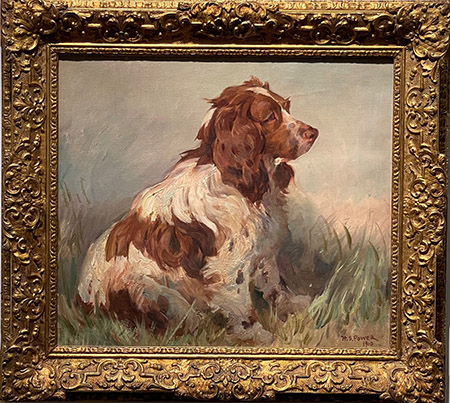
|
|
Harold Septimus Power was a New Zealand-born early to mid-twentieth century Australian artist who specialized in animal painting, especially equine subjects. Appointed an official war artist during WWI, he executed several battle pictures featuring horses and artillery in action now in the collection of the Australian War Memorial, Canberra. He exhibited in 1899 with the Melbourne Art Club then moved to Adelaide where he worked as an illustrator and political cartoonist for the Adelaide Observer, South Australian Register and the Adelaide Critic. In 1904, he was commissioned by the trustees of the Art Gallery of South Australia to paint an animal scene. Between 1905 and 1907 Power studied at the Académie Julian in Paris, and later gained a teacher's diploma at the Paris School of Arts. Settling in London, he joined the Royal Institute of Oil Painters and the Society of Animal Painters. During this time, he also exhibited at the Royal Academy of Arts, taught and painted in England, and returned to Australia in 1911 to hold his first one-man exhibition at the Guild Hall, Swanston Street, Melbourne, Australia in June 1913. During this exhibition he displayed oils and watercolours of rural landscapes that were used as backdrops for equine scenes and hunting. He returned to England later that year. Power's list of overseas achievements reads as impressively as that of any other contemporary Australian or English artist. He exhibited at the Royal Academy, at the Royal Scottish Academy, the Royal Institute of Painters in Oils, the Royal Society of Portrait Painters, the Royal Water Colour Association and the Paris Old Salon. Apologists for traditional art in Australia between the wars lauded Power's work for its nostalgic rural vision, reflecting the self-confidence, moral certainties and self-absorption of the Edwardian country-set. Arthur Streeton wrote of his rival's work: 'One is impressed first by a tremendous display of colour and a dauntless feeling of optimism He displays remarkable knowledge and vigour in his paintings of animals'. Unlike Streeton, Power did not need to reorient his pictorial emphasis for differing markets in Australia and overseas. In 1934 his only one-man London exhibition was praised for its 'healthy orthodoxy of treatment'. At the height of his fame he was seen in a line of artistic descent from Landseer to Munnings. After George Lambert's death in 1930 Power was the acknowledged leader in Australia in equine subjects. |
Home | About
the WS Gallery | Current
Exhibition | New
Additions | Search Our Inventory
| Commissioning Paintings | 19th
& 20th Century Oils | Contemporary
Artists | Works
on Paper & Collectibles | Books
| Christine Merrill
| Guest book | Email
Us
All images, designs and information on this site
are fully copyrighted © 1999
and may not be reproduced of used in any form or any manner, or displayed in
any way
on any website without the express written consent of The William Secord Gallery,
Inc.
William Secord Gallery, Inc.
29 West 15th Street 4th floor
New York, NY 10011
Between Fifth and Six Avenues
www.dogpainting.com
wsecord@dogpainting.com
Tel. 212-249-0075
212-249-0896
By appointment
